Mostrar el registro sencillo del ítem
dc.contributor.author
Gonzalez, Daniela Soledad

dc.date.available
2022-12-06T12:22:47Z
dc.date.issued
2016-06
dc.identifier.citation
Gonzalez, Daniela Soledad; Una aproximación a las bases metafóricas del lunfardo; Università degli Studi di Torino; Artifara; 16; 6-2016; 47-57
dc.identifier.issn
1594-378X
dc.identifier.uri
http://hdl.handle.net/11336/180314
dc.description.abstract
En la segunda mitad del siglo XIX se creó una especie de subcultura, en la cual hizo su aparición el fenómeno llamado lunfardo, que puede observarse hoy en muchas letras de tangos, en obras literarias y en el mismo lenguaje actual. En este trabajo se intentará demostrar que el lunfardo se encuentra realmente vigente en la actualidad porque es el resultado de operaciones conceptuales metafóricas. En primer lugar, se revisará el estado actual de los estudios sobre el lunfardo. En segundo lugar, se lo definirá. A continuación, se hará una breve caracterización del mismo observando en él la presencia de italianismos y su influencia en el tango y la literatura. En el apartado siguiente, se hablará de la presencia del lunfardo en el habla cotidiana. Luego, se comentarán los procesos de formación del lunfardo. Seguidamente, se hará una breve referencia al concepto de metáfora conceptual (Lakoff y Johnson 1980) y al de metáfora gramatical (Halliday 1985, 2004) para justificar que los procesos de formación de palabras lunfardas pueden reducirse, en última instancia, a la metáfora. Finalmente, se presentará una conclusión que reúne los aspectos trabajados.
dc.description.abstract
In the second half of the nineteenth century, a kind of subculture was created, where the phenomenon called lunfardo appeared. It can be observed today in many tango lyrics, in literature and –most importantly– in today’s language. This paper aims to demonstrate that the lunfardo is really in force today because it is a kind of metaphor, because it is the result of a universal cognitive operation. First, it will be made a short reference to the current state of studies about lunfardo; secondly, it will be defined. Then, it will be made a short characterization of it, by observing the presence of italianisms in it and its influence in tango and literature. In the next section, the presence of lunfardo in everyday speech will be discussed. After that, the lunfardo formation processes will be commented. Then, a brief reference to the notion of conceptual metaphor (Lakoff and Johnson 1980) and grammatical metaphor (Halliday 2004) will be done in order to prove that the processes of formation of lunfardo words can be reduced, ultimately, to metaphor. Finally, a conclusion will unified all this issues.
dc.format
application/pdf
dc.language.iso
spa
dc.publisher
Università degli Studi di Torino
dc.rights
info:eu-repo/semantics/openAccess
dc.rights.uri
https://creativecommons.org/licenses/by-nc-sa/2.5/ar/
dc.subject
LUNFARDO
dc.subject
HABLA COTIDIANA
dc.subject
METÁFORA
dc.subject.classification
Lingüística

dc.subject.classification
Lengua y Literatura

dc.subject.classification
HUMANIDADES

dc.title
Una aproximación a las bases metafóricas del lunfardo
dc.type
info:eu-repo/semantics/article
dc.type
info:ar-repo/semantics/artículo
dc.type
info:eu-repo/semantics/publishedVersion
dc.date.updated
2022-12-02T15:00:34Z
dc.journal.number
16
dc.journal.pagination
47-57
dc.journal.pais
Italia

dc.journal.ciudad
Torino
dc.description.fil
Fil: Gonzalez, Daniela Soledad. Universidad Nacional de Cuyo; Argentina. Consejo Nacional de Investigaciones Científicas y Técnicas; Argentina
dc.journal.title
Artifara
dc.relation.alternativeid
info:eu-repo/semantics/altIdentifier/url/https://www.ojs.unito.it/index.php/artifara/article/download/937/1522/#:~:text=En%20primer%20lugar%2C%20se%20revisar%C3%A1,el%20tango%20y%20la%20literatura.
Archivos asociados
